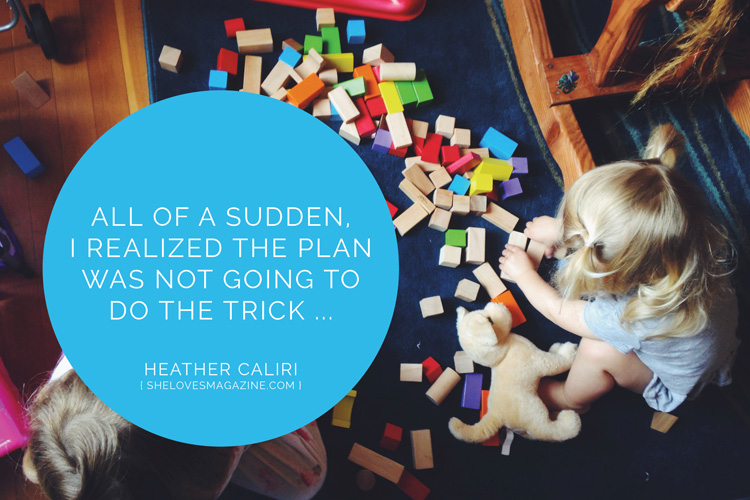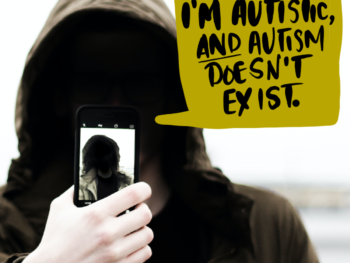
When my daughter Lucy was three, I decided to get intentional about her education.
I wanted to homeschool long-term, but knew I was not an ideal candidate: I like quiet, order, and long-range projects. I also felt a little cuckoo stuck at home. With 18 hours a day to kill, I counted the days until fifth grade.
After a bunch of research, I leaned in the airy-fairy direction for learning: lots of play, encouraging Lucy to follow her interests. However, self-directed learning goes slowly in five-minute increments. I needed a little structure.
Me being me, I made a spreadsheet.
I labeled the days of the week, and then in each square, I printed a subject area. Underneath I made lists of activities under each heading from books, websites, and Montessori catalogues.
I was ready. I had been flexible and strategic.
I hoped the plan would fix me.
I longed to homeschool my daughter. I had grown up mostly without my siblings, my father worked in other cities for most of my childhood, even my mom had often been gone when I got home from school. I so desperately wanted to be together with my kids. It was a bone-deep ache.
But I did not trust myself. I did not trust my patience and maternal goodness to last long without a plan. I did not trust myself to be kind to my kid.
If I couldn’t hack it, I’d enroll her in school rather than destroy our relationship. But then my dream of all-day togetherness would be over.
I didn’t trust myself, but I wanted to. I wanted to grow into the kind of mom who could handle being with young children all day. The plan was a start.
But what I did not admit to myself was this: I needed to be that mom now. I sensed something inside me was going to give if the hours did not get shorter.
Day one of my plan: “science.”
We built a play city using masking tape on the carpet for roads, and blocks for buildings. It was fun for both of us.
Success.
The next day, I told Lucy we could choose something from the “math” activities. I gave her six options.
“I wanna build another city!” she said.
“But that was yesterday, sweetheart,” I said firmly. “We’ll choose a counting activity today. It’ll be fun!” The idea of building a city over and over again filled me with deep foreboding. This was why I had the plan.
I got out a book of toddler math games. She ignored me. She fetched the masking tape; I tried to tempt her with counting beans.
“Just try it,” I said.
She threw the beans on the floor.
That’s when I realized my chipper spreadsheet was not going to save me.
I had created it because I was in a wilderness of time and small person needs, and I needed a map. I needed to quantify the output of our togetherness. I needed to get from morning to afternoon without banging my head against the wall.
All of a sudden, I realized the plan was not going to do the trick, at least not as easily as I’d hoped.
I had a choice to make. Would I give in to the resentment that even now was ready to drown me? Or would I choose kindness now, even if I didn’t think I’d be capable of it long-term?
I looked at Lucy. Her face had lit up with interest in her project.
She caught my gaze and was beside me in a second. “Help me, Mama!” She tugged on my sleeve.
I realized, with a sickening click, that this entreaty was what I’d hoped for when I started homeschooling. I wanted her engaged, and I wanted to be there, engaged with her.
She was engaged. Right now. Why wasn’t I?
Why wasn’t her engagement good enough for me? Why did I need to improve on it, add to it, redirect it, orchestrate it?
Why couldn’t I enter into it, instead?
I almost felt like weeping. The days were so long. I longed to be able to organize her like I’d organized all those activities on the spreadsheet, moving subjects and ideas around with no resistance.
I wanted to be in control.
I gritted my teeth and knelt down on the carpet with her. I picked up the masking tape, and grudgingly, with my face plastered with a smile I did not yet mean, I spooled out a length of tape and put it on the floor.
We built the city for another five minutes until she lost interest.
As I pulled up the tape, I realized, with a deep grief, that I had to let go of the plan. I knew my daughter, and I knew myself. She’d resist that plan every day; we’d butt heads if I insisted on it. We were both too stubborn.
I sighed, and mentally erased the tidy lines in the spreadsheet. I let go of the activities, the days, the hours, and the control, and handed the imaginary paper to my daughter.
I surrendered. Not always without gritting my teeth, no. But I surrendered to her toddlerhood.
I surrendered, because I wanted to stay with her.
But being with her cost something. It cost me my plans and my sense of control. It cost me a sense that our days were orderly and well-executed, that I was a fabulously creative parent. It cost me any illusion that if I just tried harder, being with my child would come naturally.
It cost me the luxury of getting mad at a three-year-old about the length of the days.
Blocks cleaned, I took a deep breath. I felt like I had started on a long hiking trip á la Cheryl Strayed, with my child as my backpack. We were going through arid territory, and I had to depend on her, no fooling, to survive. I had to trust that I would find some well of patience inside me. I had to trust both of us.
I got up from the floor, and went in search of my precious child.
Originally published at SheLoves Magazine in 2015.


